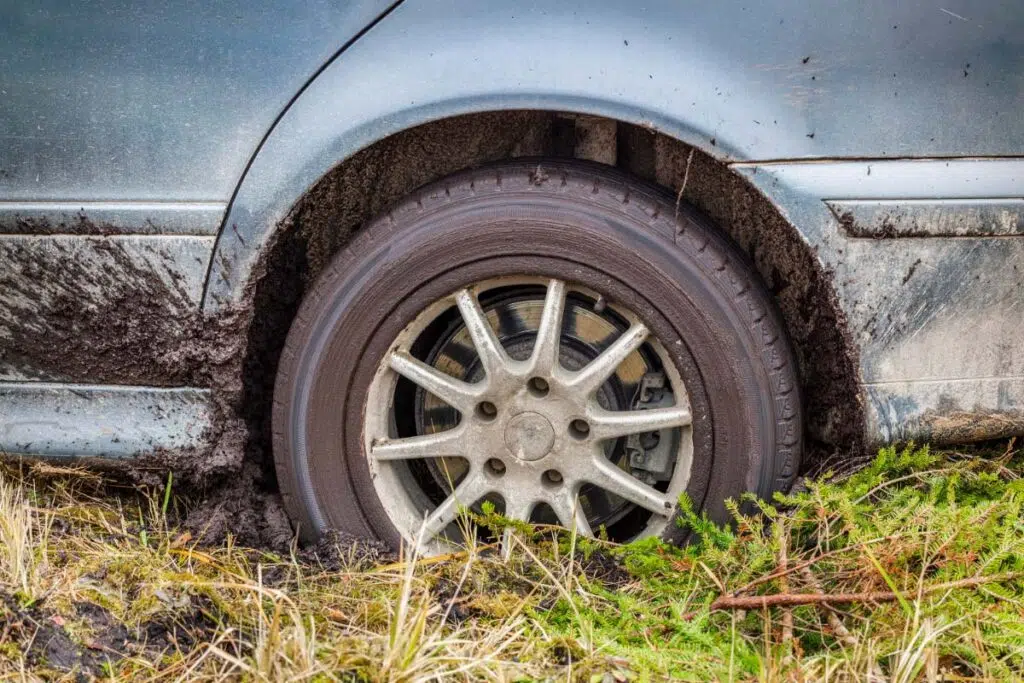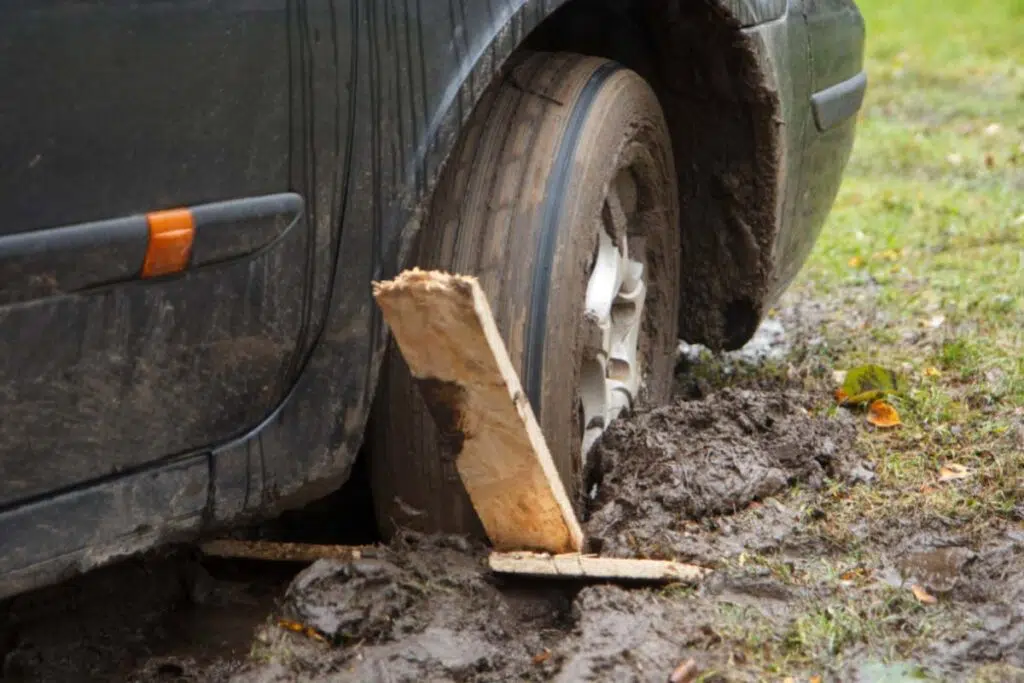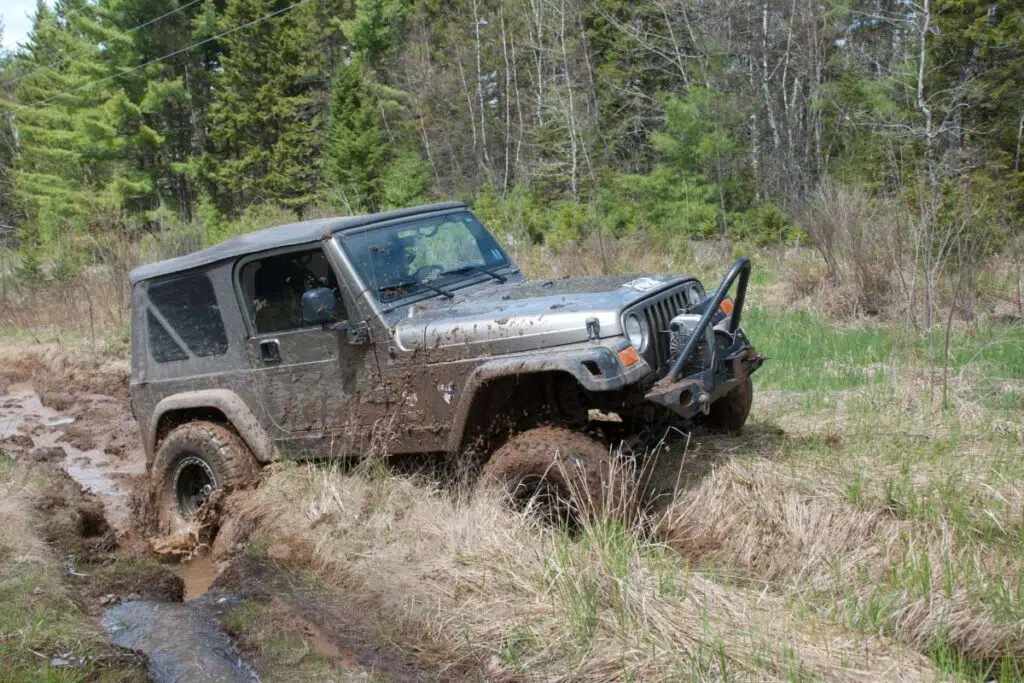With the joys of off-roading comes a price – getting your car stuck in mud. It may not always happen, but it can be a pain when it does. But then again, mudding is part of the adventure. So long as you know when to avoid mudholes and how to get your car unstuck, it is not something you should avoid.
We will cover steps in this guide – some are simple, some are labor-intensive, but all are effective ways to get you out of the muck.
Below are eight simple steps on how to free a car stuck in mud:
- Turn on your warning lights.
- Avoid wheelspin.
- Deflate your tires.
- Shift the weight inside your vehicle.
- Dig around the stuck tires.
- Increase traction with wood or cardboard.
- Use a winch.
- Call out for help.
Calling roadside assistance is the last thing on everyone’s list, as it costs anywhere between $50 and $250. But even if you were willing to pay for it, towing services may not always be available – and off-roading enthusiasts could not agree more. Hence, getting yourself out of sticky situations proves to be a crucial skill. And in today’s article, you are just about to learn how.
How to Get Your Car Unstuck from Mud

1. Turn On Your Warning Lights.
Whether on or off the pavement, you must warn oncoming vehicles of your situation. Flip the switch to turn on your warning lights, and watch out for approaching cars if you step out of your vehicle.
Getting out of your car may not always be an option, though. If your road situation is too dangerous, it might be best to call towing services at this stage.
Keeping your cool in moments like this is easier said than done. But there is no better way around it. Composure is paramount if you are to make yourself capable of assessing and getting out of the situation.
Being calm and collected will keep you from unnecessarily flooring the gas and help you think of solutions quicker.
As you think of the best way to get your car unstuck from mud, it is advisable to stop and step out of the vehicle (especially when you have passengers and if circumstances permit). Doing so helps take the weight off your wheeler and reduce the likelihood of it sinking further into the mud.
2. Avoid Wheelspin.
Flooring the gas is a no-no in muddy situations because it creates wheelspin and only exacerbates the situation. Unfortunately, some drivers mistakenly believe that wheelspin always helps mobilize a stuck vehicle. In truth, this is a myth.
If you want to get your car moving, move your steering wheel back and forth instead to create enough room for your tires to maneuver. As you do this Rocking Method, quickly change from reverse to drive.
However, be mindful not to perform this procedure more than eight times or longer than five minutes, lest you risk causing serious drivetrain damage.
You are in luck if you own a hybrid, EV (electric vehicle), or automatic, as it takes less footwork shifting from reverse to drive (and vice-versa) on these cars compared to a manual.
Once that ‘room’ is created, go on 2nd or 3rd gear, release the clutch, and gently depress the accelerator pedal as slowly as possible while using the vehicle’s weight to gain traction. This step applies to manual transmissions specifically – if you drive an automatic, just put your car in its lowest gear setting.
3. Deflate Your Tires.
Most seasoned drivers can free a car stuck in mud by doing only the Rocking Method. But if it does not work out for you the same way, you may need to increase your tires’ contact patch by deflating them.
As a general rule, 15 psi is the maximum you can let air out of your tires.
This procedure should be done gradually, airing out an initial 7.0 psi and going from there if the created surface patch does not suffice. It is also best to use a tire pressure gauge like Motion Pro Digital Tire Pressure Gauge (view on Amazon) to ensure your tires are not over-deflated.
4. Shift the Weight Inside Your Vehicle.
Also called the “shifting weight method,” this step implies exactly what you have to do – redistribute the weight in your car so that heavier objects are positioned over your drive wheels. Doing so increases the “downward force exerted on your wheels,” which would allow you to regain traction and get your tires rolling.
The only setback with this is that it is not 100% foolproof, as its success largely depends on how deep the mud is. Do not be too frustrated if this trick does not work – there are more ways how to get a car out of mud.
5. Dig Around the Stuck Tires.
Sometimes, a small shovel like Zune Lotoo Survival Shovel (view on Amazon) can do wonders in getting a car unstuck from mud (the same way it does vehicles stuck in snow). With deep mud is accumulated wetness surrounding the affected tires.
If you can eliminate some of the wetness, your tires will have better chances of gripping on “drier” mud and propelling themselves forward and out of the sticky situation.
6. Increase Traction With Wood or Cardboard.

Creating a dry surface for extra grip is another invaluable hack and is often done synchronously with deflating tires. This approach is quite similar to getting a vehicle unstuck from snow. But instead of granular objects, you will need something rough for your tires to bite and get the car moving.
Two things that come to mind are wood and cardboard – coarse, flat, and often accessible when driving outdoors. Using the back of floor mats or carpet squares are good alternatives, too (especially if they are the only things available at your disposal).
7. Use a Winch.
Off-roader or not, a recovery winch should be a staple in your on-/off-road emergency kit. After all, you can never really tell when unforeseen scenarios (or deep mudholes) will appear next.
Like what I mentioned in my other articles, a recovery winch like Warn 103253 VR EVO 10-S Electric 12V DC Winch with Synthetic Rope: 10,000 lb Pulling Capacity (view on Amazon) is excellent insurance against sticky situations and an irrefutable must-have. You will need a sturdy structure to attach to when the need to use one arises.
8. Call Out for Help.
Even veteran drivers call out for assistance when affronted with mud too thick and too deep. That said, you should never feel embarrassed to do the same.
Because of the irregularity of this occurrence, we will often find ourselves alone and in a strange place when situations like this happen. Neither friends nor helpful bystanders will always be present to come to our aid. And so, calling roadside assistance is but inevitable.
It does not necessarily follow that screaming help equals your incapability to free your car stuck in mud. On the contrary, it would mean you have exhausted everything within your means to yank your vehicle out of the muck on your own.
There is nothing left to do but outsource the task to a professional. On this note, make sure you have the contact number of local towing services saved on your phone.
Once you can get your vehicle out of the muck successfully, shed any excess mud from your tires by driving slowly for a while. Follow this with a thorough inspection of your vehicle.
Check for signs of damage – brake lines are a good area to look into. If you have deflated your tires in the process, remember to inflate them back to spec before continuing on your driving spree.
To side with caution, do a second round of car inspection as soon as you get home and after cleaning your vehicle. You may do this yourself or with the help of a professional mechanic.
How to Get Out of Mud Without a Winch
In the absence of a winch but with help from another 4×4 vehicle with a locking differential (an SUV, truck, etc.), you can perform a snatch recovery. Unlike the usual tow, this rescue method uses corresponding snatch straps (view on Amazon) and an anchor to connect two cars without the need for the strap to be tensioned all the way.
It is also not something you do with a tow ball, rope, or chain, as these recovery items are designed to rescue free-moving and not stuck vehicles. Furthermore, they can become dangerous projectiles in the off chance that they snap.
Snatch Strap Recovery Steps:
- Attach the snatch strap to the rescuing vehicle’s recovery point, and let the strap rest on the ground.
- Back your car at a certain distance that when the snatch strap is put onto the stuck vehicle, the latter would be nice and tight.
- To prepare for the unlikely event of the snatch strap breaking, place a strap damper in the middle of the strap.
- With both drivers communicating from behind the wheel, the rescuing driver should depress the accelerator, but not all the way.
- When the strap feels like it is trying to maneuver the stuck car out of the mud, the driver of the latter should start accelerating forward, matching the speed of the recovery vehicle.
How to Drive Through Mud (10 Tips)

1. Measure the Depth of the Mud With a Stick.
Never mind getting dirty, so long as you can prevent a more troublesome mishap down the road.
2. Avoid the Mud if Tire Tracks Go In but Do Not Come Out.
This is another trick you can do if you prefer not to dirty your kicks but still want to drive on the safe side. Additionally, avoid deep grooves even if you see incoming and outgoing tire tracks. These grooves are softer and more prone to getting your tires stuck.
3. Activate Traction Control.
Although this feature is set off automatically in severe conditions, it is best to activate it beforehand when you are about to traverse muddy roads. Doing so makes the responsiveness of the Traction Control closer to spot-on, which means less propensity for your vehicle to get stuck in mud.
4. Disable Traction Control.
If your car is already stuck, you will have to do the reverse – turn Traction Control off. Disabling the feature takes pressure off the engine and makes it slightly easier for your vehicle to get unstuck from the mud.
5. Switch to 4H (4-Hi) or 4L (4-Lo).
Manually switching drive modes only applies to vehicles with part-time 4WD systems. It is unnecessary if your wheeler has AWD (All-Wheel Drive) or permanent 4WD. Between the two, 4L is the way to go if you are caught in a terrible muddy situation.
6. Ensure You Have No Wheel Slip.
Your wheels – especially your drive wheels – should always line up with the direction of your steering wheel. If they do not (when they move towards a different direction), it means your wheels are slipping. Rectify this at the earliest sign of the problem. Otherwise, you will find yourself in a more difficult situation as you attempt to get your vehicle unstuck from the mud.
7. Take It Easy on the Speed.
Speeding through mud does nothing but cause you to lose control in muddy situations. Conversely, driving too slow will only sink you deeper into the mud. Finding the right balance and moving your steering wheel from left to right will help you increase traction.
8. Choose the Right Tires and Keep Them Properly Inflated.
A typical error of adventurers is that they fail to change their tires (whether unwittingly or otherwise) before taking on muddy road conditions. While this is often an honest mistake, it can be very costly. Quiet tires on the highway are never a good tradeoff for getting stuck in muck. That said, equip your car with mud tires during the muddy season.
9. Use Car Mud Flaps.
Mud flaps reduce the amount of mud that sticks to your tires by catching dirt and mud kicked up off the road. They may take a while to clean after, but they help reduce the likelihood of your vehicle getting stuck in mud.
Avoid sudden braking or accelerating. Sudden stops and hard acceleration make your vehicle prone to skidding. To avoid this, make sure you step on the brakes or the accelerator pedal gently.
10. Carry an On-/Off-Road Emergency Kit.
Always having an emergency kit inside your car trunk is a no-brainer. Especially for vehicles based in locations with all four seasons, having safety items at their disposal is vital. Ultimately, you decide what goes in your emergency kit. But at the very least, it should have the following:
- Winch and snatch straps
- Shovel
- Car jack
- Wood planks
- Carpet or rubber mats
- Cardboard
- Gravel, kitty litter, and sand
- Wheel tracks or traction boards
Conclusion – How to Get a Car Out of Mud
In summary, here are the eight steps on how to get a car out of the mud:
- Turn on your warning lights.
- Avoid wheelspin.
- Deflate your tires.
- Shift the weight inside your vehicle.
- Dig around the stuck tires.
- Increase traction with wood or cardboard.
- Use a winch.
- Call out for help.
Besides some steps, getting your car out of mud is not necessarily a two-person job. However, it entails being calm and having an emergency kit.
But the best way to go about the scenario is through prevention – which is why I included recommendations on how to prepare for a muddy riding experience. If all safety measures are done before embarking on muddy roads, the chances of being stuck in mud will be dramatically reduced.
Kris is an avid off-roader and outdoor enthusiast who loves to brave the elements and take on challenging terrain. He also enjoys sharing his passion and knowledge with others so that they, too, can appreciate the ride.
About Kris
